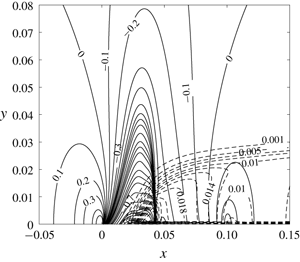Published online by Cambridge University Press: 13 December 2019

A small-disturbance asymptotic model is derived to describe the complex nature of a pure water vapour flow with non-equilibrium and homogeneous condensation around a thin airfoil operating at transonic speed and small angle of attack. The van der Waals equation of state provides real-gas relationships among the thermodynamic properties of water vapour. Classical nucleation and droplet growth theory is used to model the condensation process. The similarity parameters which determine the flow and condensation physics are identified. The flow may be described by a nonlinear and non-homogeneous partial differential equation coupled with a set of four ordinary differential equations to model the condensation process. The model problem is used to study the effects of independent variation of the upstream flow and thermodynamic conditions, airfoil geometry and angle of attack on the pressure and condensate mass fraction distributions along the airfoil surfaces and the consequent effect on the wave drag and lift coefficients. Increasing the upstream temperature at fixed values of upstream supersaturation ratio and Mach number results in increased condensation and higher wave drag coefficient. Increasing the upstream supersaturation ratio at fixed values of upstream temperature and Mach number also results in increased condensation and the wave drag coefficient increases nonlinearly. In addition, the effects of varying airfoil geometry with a fixed thickness ratio and chord on flow properties and condensation region are studied. The computed results confirm the similarity law of Zierep & Lin (Forsch. Ing. Wes. A, vol. 33 (6), 1967, pp. 169–172), relating the onset condensation Mach number to upstream stagnation relative humidity, when an effective specific heat ratio is used. The small-disturbance model is a useful tool to analyse the physics of high-speed condensing steam flows around airfoils operating at high pressures and temperatures.